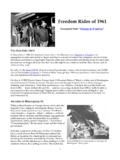Transcription of motion graphs - bj's MST
1 motion graphs 1 M. Poarch 2003 Name_____ motion graphs Describing the motion of an object is occasionally hard to do with words. Sometimes graphs help make motion easier to picture, and therefore understand. Remember: motion is a change in position measured by distance and time. Speed tells us the rate at which an object moves. Velocity tells the speed and direction of a moving object. Acceleration tells us the rate speed or direction changes. DISTANCE-TIME graphs Plotting distance against time can tell you a lot about motion . Let's look at the axes: If an object is not moving, a horizontal line is shown on a distance-time graph . Time is always plotted on the X-axis (bottom of the graph ).
2 The further to the right on the axis, the longer the time from the start. Distance is plotted on the Y-axis (side of the graph ). The higher up the graph , the further from the start. Time is increasing to the right, but its distance does not change. It is not moving. We say it is At Rest. motion graphs 2 M. Poarch 2003 If an object is moving at a constant speed, it means it has the same increase in distance in a given time: Let s look at two moving objects: Both of the lines in the graph show that each object moved the same distance, but the steeper dashed line got there before the other one: graphs that show acceleration look different from those that show constant speed.
3 Time is increasing to the right, and distance is increasing constantly with time. The object moves at a constant speed. Constant speed is shown by straight lines on a graph . A steeper line indicates a larger distance moved in a given time. In other words, higher speed. Both lines are straight, so both speeds are constant. The line on this graph is curving upwards. This shows an increase in speed, since the line is getting steeper: In other words, in a given time, the distance the object moves is change (getting larger). It is graphs 3 M. Poarch 2003 Summary: A distance-time graph tells us how far an object has moved with time. The steeper the graph , the faster the motion .
4 A horizontal line means the object is not changing its position - it is not moving, it is at rest. A downward sloping line means the object is returning to the start. ( graph from: ) motion graphs 4 M. Poarch 2003 Examine the graphs below. Which of the following graphs indicates that one of runners started 10 yards further ahead of the other? Which of the graphs shows that one of runners started 10 yards further ahead of the other? Explain your answer. In motion graphs 5 M. Poarch 2003 In which of the following graphs below are both runners moving at the same speed? Explain your answer. motion graphs 6 M. Poarch 2003 The distance-time graphs below represent the motion of a car.
5 Match the descriptions with the graphs . Explain your answers. Descriptions: 1. The car is stopped. 2. The car is traveling at a constant speed. 3. The speed of the car is decreasing. 4. The car is coming back. graph A matches description _____ because _____. graph B matches description _____ because _____. graph C matches description _____ because _____. graph D matches description _____ because _____. motion graphs 7 M. Poarch 2003 SPEED-TIME graphs Speed-Time graphs are also called Velocity-Time graphs . Speed-Time graphs look much like Distance-Time graphs . Be sure to read the labels!! Time is plotted on the X-axis. Speed or velocity is plotted on the Y-axis.
6 A straight horizontal line on a speed-time graph means that speed is constant. It is not changing over time. A straight line does not mean that the object is not moving! This graph shows increasing speed. The moving object is graph shows decreasing speed. The moving object is decelerating. motion graphs 8 M. Poarch 2003 What about comparing two moving objects at the same time? Summary: A speed - time graph shows us how the speed of a moving object changes with time. The steeper the graph , the greater the acceleration. A horizontal line means the object is moving at a constant speed. A downward sloping line means the object is slowing down. ( graph from: ) Both the dashed and solid line show increasing speed.
7 Both lines reach the same top speed, but the solid one takes longer. The dashed line shows a greater acceleration. motion graphs 9 M. Poarch 2003 The speed-time graphs below represent the motion of a car. Match the descriptions with the graphs . Explain your answers. Descriptions: 5. The car is stopped. 6. The car is traveling at a constant speed. 7. The car is accelerating. 8. The car is slowing down. graph E matches description _____ because _____. graph F matches description _____ because _____. graph G matches description _____ because _____. graph H matches description _____ because _____. motion graphs 10 M. Poarch 2003 Questions: ( Some questions adapted from ) Look at the graph above.
8 It shows how three runners ran a 100-meter race. Which runner won the race? Explain your answer. Which runner stopped for a rest? Explain your answer. How long was the stop? Explain your answer. How long did Bob take to complete the race? Explain your answer. Calculate Albert s average speed. (Figure the distance and the time first!) motion graphs 11 M. Poarch 2003 The graph below shows how the speed of a bus changes during part of a journey Choose the correct words from the following list to describe the motion during each segment of the journey to fill in the blanks. accelerating decelerating constant speed at rest Segment 0-A The bus is _____.
9 Its speed changes from 0 to 10 m/s in 5 seconds. Segment A-B The bus is moving at a _____of 10 m/s for 5 seconds. Segment B-C The bus is _____. It is slowing down from 10 m/s to rest in 3 seconds. Segment C-D The bus is _____. It has stopped. Segment D-E The bus is _____. It is gradually increasing in speed.







